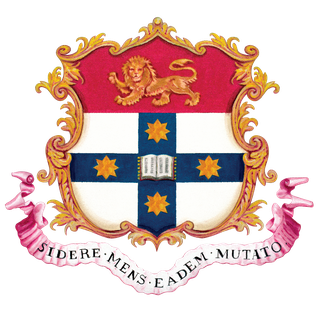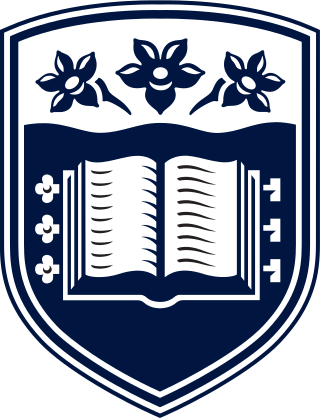
James R. Curran is a computational linguist and was a senior lecturer at the University of Sydney and former CEO of Grok Academy. He holds a PhD in Informatics from the University of Edinburgh.

James R. Curran is a computational linguist and was a senior lecturer at the University of Sydney and former CEO of Grok Academy. He holds a PhD in Informatics from the University of Edinburgh.
Curran's research focuses on natural language processing. [1] Specifically Curran's research has focused on the area of natural language processing known as combinatory categorial grammar parsing. In addition to his contributions to NLP, Curran has produced a paper on the development of search engines to assist in driving problem based learning. [2]
Within NLP, he has published papers on combinatory categorial grammar parsing as well as question answering systems. [3]
Curran has co-authored software packages such as C&C tools, [4] a CCG parser (with Stephen Clark). [5]
In addition to his work as a University of Sydney lecturer, Curran directed the National Computer Science School, an annual summer school for technologically talented high school students. [6] In 2013, based on their work with NCSS, he, Tara Murphy, Nicky Ringland and Tim Dawborn founded Grok Learning. [7]
In 2013 he was one of the authors of the Digital Technologies section of the Australian Curriculum - its first appearance in the national curriculum. [8] Additionally, he acted as an advocate for digital literacy among Australian students. [9] [10]
He was the academic director of the Australian Computing Academy, a not-for-profit within the University of Sydney [11] until its merger with Grok Learning in 2021 to form Grok Academy. [12]
In October 2024 he resigned from his position as CEO and board member of Grok Academy after multiple allegations of harassment were substantiated by an independent investigator. [13] It was reported that over a 10-year span there were nine women, including six who were in high school at the time, that allege Curran sent them inappropriate messages.
Additionally, it was revealed that a 2019 University of Sydney investigation found 35 cases of harassment, after which he received a warning and a 2024 University of New South Wales investigation was referred to the NSW police, who took no action as they found no criminal wrongdoing by Curran, in part because the students were over 16 at the time of the alleged harassment. [13]
Natural language processing (NLP) is a subfield of computer science and especially artificial intelligence. It is primarily concerned with providing computers with the ability to process data encoded in natural language and is thus closely related to information retrieval, knowledge representation and computational linguistics, a subfield of linguistics. Typically data is collected in text corpora, using either rule-based, statistical or neural-based approaches in machine learning and deep learning.

The University of Sydney (USYD) is a public research university in Sydney, Australia. Founded in 1850, it is the oldest university in both Australia and Oceania. One of Australia's six sandstone universities, it was one of the world's first universities to admit students solely on academic merit, and opened its doors to women on the same basis as men. The university comprises eight academic faculties and university schools, through which it offers bachelor, master and doctoral degrees.
Neuro-linguistic programming (NLP) is a pseudoscientific approach to communication, personal development and psychotherapy, that first appeared in Richard Bandler and John Grinder's 1975 book The Structure of Magic I. NLP asserts that there is a connection between neurological processes, language and acquired behavioral patterns, and that these can be changed to achieve specific goals in life. According to Bandler and Grinder, NLP can treat problems such as phobias, depression, tic disorders, psychosomatic illnesses, near-sightedness, allergy, the common cold, and learning disorders, often in a single session. They also say that NLP can model the skills of exceptional people, allowing anyone to acquire them.

James Cook University (JCU) is a public university in North Queensland, Australia. The second oldest university in Queensland, JCU is a teaching and research institution. The university's main campuses are located in the tropical cities of Cairns and Townsville, and one in the city state of Singapore. JCU also has study centres in Mount Isa, Mackay, Thursday Island and Rockhampton. A Brisbane campus, operated by Russo Higher Education, delivers undergraduate and postgraduate courses to international students. The university's main fields of research include environmental sciences, biological sciences, mathematical sciences, earth sciences, agricultural and veterinary sciences, technology and medical and health sciences.

Curtin University is an Australian public research university based in Bentley, Perth, Western Australia. It is named after John Curtin, Prime Minister of Australia from 1941 to 1945, and is Western Australia's largest university, with 58,607 students in 2022.

The University of Wollongong (UOW) is an Australian public research university located in the coastal city of Wollongong, New South Wales, approximately 80 kilometres (50 mi) south of Sydney. As of 2023, the university had an enrolment of more than 33,000 students, an alumni base of more than 176,000 [LC1] and over 2,400 staff members including 16 Distinguished professors.
Tree-adjoining grammar (TAG) is a grammar formalism defined by Aravind Joshi. Tree-adjoining grammars are somewhat similar to context-free grammars, but the elementary unit of rewriting is the tree rather than the symbol. Whereas context-free grammars have rules for rewriting symbols as strings of other symbols, tree-adjoining grammars have rules for rewriting the nodes of trees as other trees.
Link grammar (LG) is a theory of syntax by Davy Temperley and Daniel Sleator which builds relations between pairs of words, rather than constructing constituents in a phrase structure hierarchy. Link grammar is similar to dependency grammar, but dependency grammar includes a head-dependent relationship, whereas link grammar makes the head-dependent relationship optional. Colored Multiplanar Link Grammar (CMLG) is an extension of LG allowing crossing relations between pairs of words. The relationship between words is indicated with link types, thus making the Link grammar closely related to certain categorial grammars.

Richard Merritt Montague was an American mathematician and philosopher who made contributions to mathematical logic and the philosophy of language. He is known for proposing Montague grammar to formalize the semantics of natural language. As a student of Alfred Tarski, he also contributed early developments to axiomatic set theory (ZFC). For the latter half of his life, he was a professor at the University of California, Los Angeles until his early death, believed to be a homicide, at age 40.
Categorial grammar is a family of formalisms in natural language syntax that share the central assumption that syntactic constituents combine as functions and arguments. Categorial grammar posits a close relationship between the syntax and semantic composition, since it typically treats syntactic categories as corresponding to semantic types. Categorial grammars were developed in the 1930s by Kazimierz Ajdukiewicz and in the 1950s by Yehoshua Bar-Hillel and Joachim Lambek. It saw a surge of interest in the 1970s following the work of Richard Montague, whose Montague grammar assumed a similar view of syntax. It continues to be a major paradigm, particularly within formal semantics.
Roger Carl Schank was an American artificial intelligence theorist, cognitive psychologist, learning scientist, educational reformer, and entrepreneur. Beginning in the late 1960s, he pioneered conceptual dependency theory and case-based reasoning, both of which challenged cognitivist views of memory and reasoning. He began his career teaching at Yale University and Stanford University. In 1989, Schank was granted $30 million in a ten-year commitment to his research and development by Andersen Consulting, through which he founded the Institute for the Learning Sciences (ILS) at Northwestern University in Chicago.

Cranbrook School is an independent Anglican day and boarding school, with multiple campuses in Sydney's eastern suburbs New South Wales, Australia for students from pre-school to year 12. The school was founded in 1918 with the Rev'd Frederick Thomas Perkins as the first headmaster. Cranbrook has a non-selective enrollment policy and currently caters for approximately 1,680 students from early learning to Year 12, including 80 boarders from Years 7 to 12. Cranbrook is affiliated with the Association of Heads of Independent Schools of Australia (AHISA), the Junior School Heads Association of Australia (JSHAA), the Australian Boarding Schools' Association (ABSA), and the Headmasters' and Headmistresses' Conference. It is a founding member of the Combined Associated Schools (CAS). and the Independent Sporting Association (ISA).
Gordon Leslie Ada AO, FAA was an Australian biochemist best known for his seminal contributions to virology and immunology and his long leadership of the Department of Microbiology at the John Curtin School of Medical Research at the Australian National University, where Peter C. Doherty and Rolf Zinkernagel performed their Nobel winning research in his department. Both Zinkernagel and Doherty held him in high regard, and he was invited by them to attend the Nobel award ceremony and dinner in Stockholm.
Eugene Charniak was a professor of computer Science and cognitive Science at Brown University. He held an A.B. in Physics from the University of Chicago and a Ph.D. from M.I.T. in Computer Science. His research was in the area of language understanding or technologies which relate to it, such as knowledge representation, reasoning under uncertainty, and learning. Since the early 1990s he was interested in statistical techniques for language understanding. His research in this area included work in the subareas of part-of-speech tagging, probabilistic context-free grammar induction, and, more recently, syntactic disambiguation through word statistics, efficient syntactic parsing, and lexical resource acquisition through statistical means.
Combinatory categorial grammar (CCG) is an efficiently parsable, yet linguistically expressive grammar formalism. It has a transparent interface between surface syntax and underlying semantic representation, including predicate–argument structure, quantification and information structure. The formalism generates constituency-based structures and is therefore a type of phrase structure grammar.
Explanation-based learning (EBL) is a form of machine learning that exploits a very strong, or even perfect, domain theory in order to make generalizations or form concepts from training examples. It is also linked with Encoding (memory) to help with Learning.
Deep linguistic processing is a natural language processing framework which draws on theoretical and descriptive linguistics. It models language predominantly by way of theoretical syntactic/semantic theory. Deep linguistic processing approaches differ from "shallower" methods in that they yield more expressive and structural representations which directly capture long-distance dependencies and underlying predicate-argument structures.
The knowledge-intensive approach of deep linguistic processing requires considerable computational power, and has in the past sometimes been judged as being intractable. However, research in the early 2000s had made considerable advancement in efficiency of deep processing. Today, efficiency is no longer a major problem for applications using deep linguistic processing.
In computational linguistics, the term mildly context-sensitive grammar formalisms refers to several grammar formalisms that have been developed in an effort to provide adequate descriptions of the syntactic structure of natural language.
Google Kythe is a source code indexer and cross-referencer for code comprehension which describes itself as a "pluggable, (mostly) language-agnostic ecosystem for building tools that work with code".
Prof. Tara Murphy is an Australian Astrophysicist and CAASTRO chief investigator working in the School of Physics at the University of Sydney. Murphy led a group that first confirmed radio emissions from the 2017 Neutron Star Merger event which provided evidence for a global scientific announcement in the field of gravitational waves.